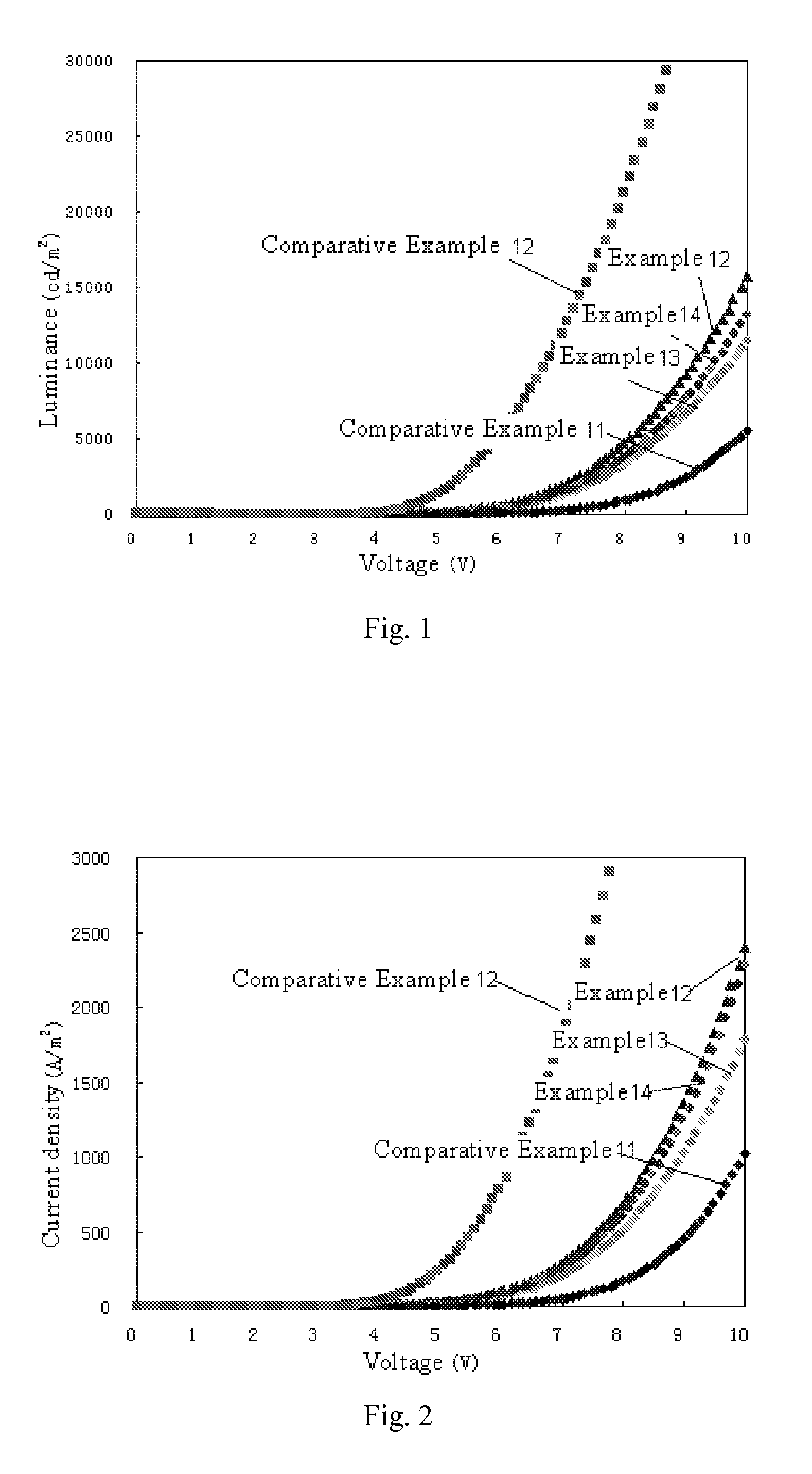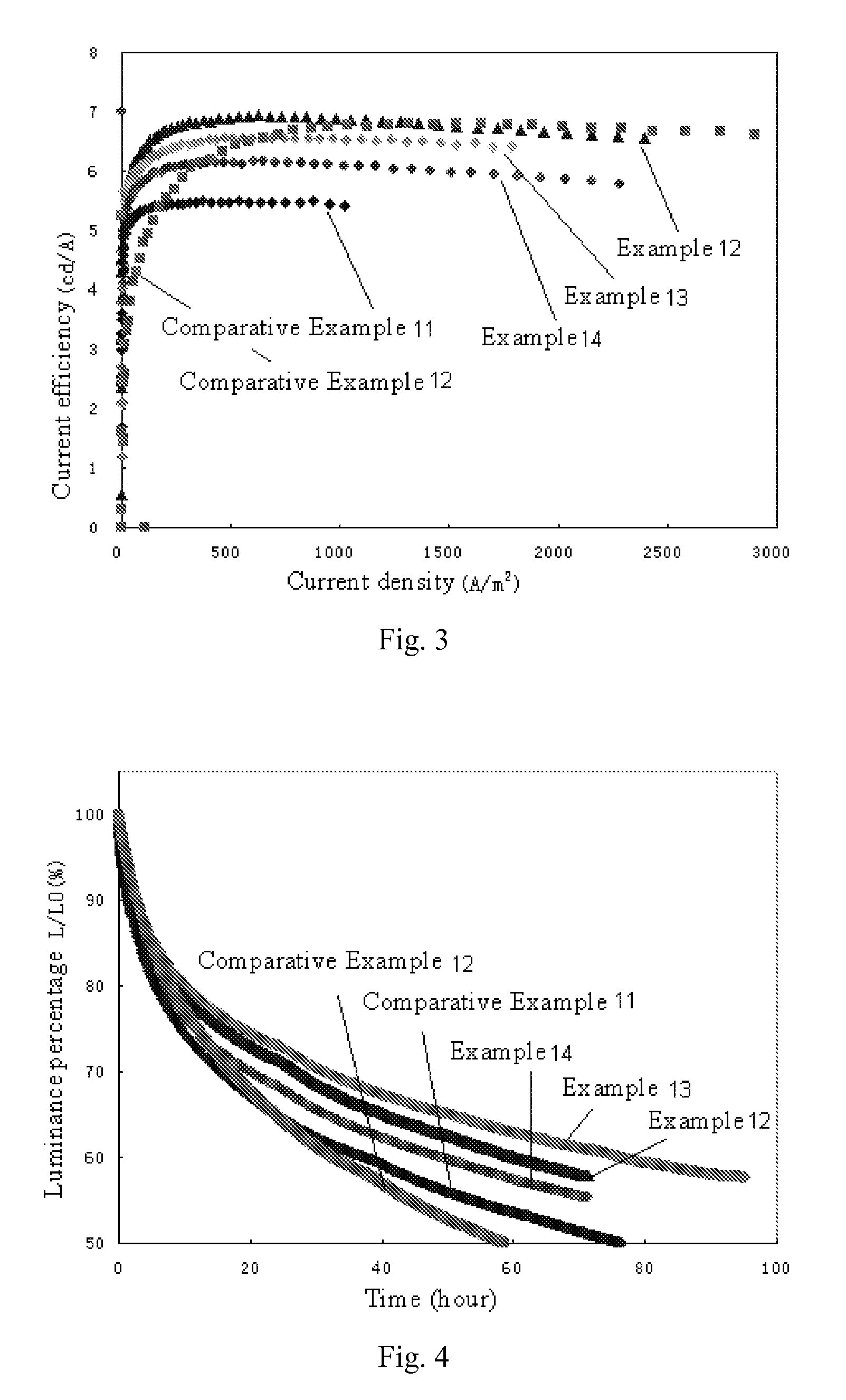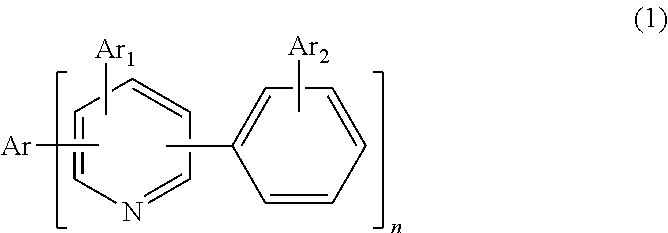Organic materials and organic electroluminescent apparatuses using the same
a technology of organic electroluminescent apparatus and organic material, which is applied in the direction of luminescent compositions, chemistry apparatus and processes, organic chemistry, etc., can solve the problems of molecule prone to form crystals instead of film, and achieve good electron accepting ability, enhance the film-forming property, and the planar regularity of fused-ring aromatic compounds is better.
- Summary
- Abstract
- Description
- Claims
- Application Information
AI Technical Summary
Benefits of technology
Problems solved by technology
Method used
Image
Examples
synthesis example 1
Synthesis of Compound 2-1
[0051](1) Reaction of the First Step
[0052]
[0053]After argon replacement in a three-neck bottle of 500 ml equipped with magnetic stirrer, 13.4 g of 2-iodo-5-bromopyridine (purity of 99%, 0.0473 mol) and 200 ml of THF are sequentially added thereto. 19 ml of n-butyl lithium (concentration of 2.5 M, 0.0475 mol) is dropwise added at −83° C., and then 4.8 g of anthraquinone (purity of 99%, 0.023 mol) is immediately added. After addition, the temperature is naturally raised to room temperature, and the solution exhibits bright yellow color. 200 ml of water is added for hydrolysis, the resultant is extracted with ethyl acetate, and the solvent is evaporated. After adding 300 ml of acetic acid, 18 g of KI and 18 g of sodium hypophosphite, the resultant is refluxed and allowed to react for 1 hour. Then, the temperature is reduced, acetic acid is evaporated, and the resultant is washed with water. Thus, 5.05 g of yellow compound is obtained with purity of 87.42% and y...
synthesis example 2
Synthesis of Compound 2-3
[0058]The pale yellow compound 2-3 is obtained by using anthraquinone, 2-iodo-4-bromopyridine and phenyl boric acid via the same two-step reaction as in the Example 1.
[0059]Mass Spectrum (MS) of the product (m / e): 484; Elemental analysis (C36H24N2): Theoretical, C: 89.23%, H: 4.99%, N: 5.78%; Measured, C: 89.21%, H: 5.05%, N: 5.74%.
synthesis example 3
Synthesis of Compound 2-5
[0060](1) Reaction of the First Step
[0061]
[0062]After argon replacement in a three-neck bottle of 500 ml equipped with magnetic stirrer, 8.26 g of 2-iodo-5-bromopyridine (purity of 99%, 0.0288 mol), 3.58 g of phenyl boric acid (purity of 98%, 0.0292 mol), 1.79 g of Pd(PPh3)4 (AR, 0.00155 mol), 175 ml of aqueous solution of sodium carbonate (concentration of 2M), 175 ml of benzene, and 175 ml of ethanol are sequentially added thereto, refluxed, and allowed to react for 2 hours. The temperature is reduced, and the organic layer is separated and evaporated. The resultant is subjected to column separation with ethyl acetate / petroleum ether in a ratio of 1 / 20. Thus, 6.75 g of product is obtained with purity of 95.45% and yield of 94.43%.
[0063](2) Reaction of the Second Step
[0064]
[0065]After nitrogen replacement in a three-neck bottle of 500 ml equipped with magnetic stirrer, 6.75 g of 2-phenyl-5-bromopyridine (purity of 95.45%, 0.0274 mol) and 110 ml of THF are s...
PUM
| Property | Measurement | Unit |
|---|---|---|
| thickness | aaaaa | aaaaa |
| thickness | aaaaa | aaaaa |
| thickness | aaaaa | aaaaa |
Abstract
Description
Claims
Application Information
 Login to View More
Login to View More - R&D
- Intellectual Property
- Life Sciences
- Materials
- Tech Scout
- Unparalleled Data Quality
- Higher Quality Content
- 60% Fewer Hallucinations
Browse by: Latest US Patents, China's latest patents, Technical Efficacy Thesaurus, Application Domain, Technology Topic, Popular Technical Reports.
© 2025 PatSnap. All rights reserved.Legal|Privacy policy|Modern Slavery Act Transparency Statement|Sitemap|About US| Contact US: help@patsnap.com



